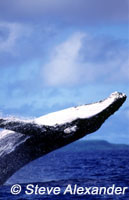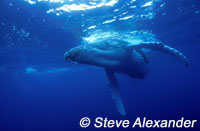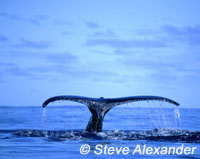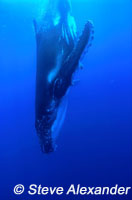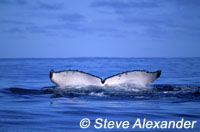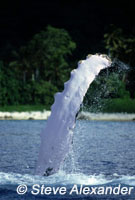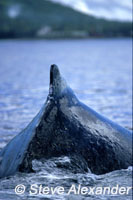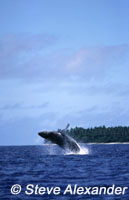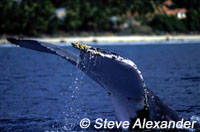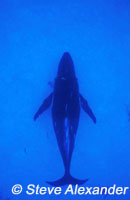|
Humpback
Whale Encounters - Year 2000
|
|
All images are copyright protected and ABSOLUTELY NO USE is permitted without written consent of Steve Alexander. For permission to use photos, please email Steve. |
|
| Click
here for Jen's exciting narrative of swimming with Humpbacks |
|
|
Breach |
|
|
Humpback Calf
|
|
|
Leviathon |
|
|
Diving Calf |
|
|
|
|
|
Dive |
|
|
|
|
|
Pec Slap
Rarotonga, Cook Islands #23312. The Humpback Whale has the largest appendage of the animal kingdom; it's pectoral flipper, or "pec" which can reach 15' (5m) in length. This whale is "pec-slapping", banging it's huge pec on the surface of the water. This is thought to be a means of communicating with other whales. |
|
|
Mammalian
Mass
Rarotonga, Cook Islands #22433. At 30 to 40 tons and 20X the size of an elephant, the Humpback Whale is truly a huge mammal. The scars on the back of this one are from "Cookie Cutter Sharks" which take circular bites from the whales as free snacks! I guess we could compare it with being bitten by a mosquito! |
|
|
Freedom
Vava'u, Tonga #36836. Nothing is more exhilarating than seeing a Humpback shooting clean out of the water. |
|
|
Barnacled
Rarotonga, Cook Islands #23333. Barnacles attach themselves to the leading edges of the whales flukes. |
|
|
Cruisin'
Beveridge Reef #27507. A two year old Humpback cruises in the shallow coral lagoon of a remote seamount. |
|
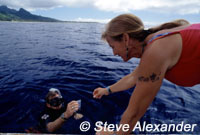 |
Collecting Skin Samples |
